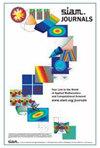关于深度活动子空间方法
IF 2.1
3区 工程技术
Q2 MATHEMATICS, INTERDISCIPLINARY APPLICATIONS
引用次数: 1
摘要
. 深度主动子空间方法是一种基于神经网络的工具,用于通过具有高维输入空间的计算模型传播不确定性。与原始的活动子空间方法不同,它不需要访问模型的梯度。它依赖于用Gram- Schmidt正交构造的正交投影矩阵来降低输入维数。该矩阵作为第一隐层(作为正交编码器)的权重矩阵并入神经网络,并使用反向传播优化以识别输入的活动子空间。我们提出了几个理论扩展,从Gram- Schmidt向量导数的一个新的解析关系开始,这是反向传播所必需的。我们还研究了向量值模型输出的使用,这在原始的活动子空间方法中是困难的。此外,我们还研究了一种具有编码器的替代神经网络,该编码器没有嵌入正交性,与深度有源子空间方法相比,它具有同样好的性能。两个流行病学模型被认为是应用,其中一个需要超级计算机访问来生成训练数据。本文章由计算机程序翻译,如有差异,请以英文原文为准。
On the Deep Active-Subspace Method
. The deep active-subspace method is a neural-network based tool for the propagation of uncertainty through computational models with high-dimensional input spaces. Unlike the original active-subspace method, it does not require access to the gradient of the model. It relies on an orthogonal projection matrix constructed with Gram--Schmidt orthogonalization to reduce the input dimensionality. This matrix is incorporated into a neural network as the weight matrix of the first hidden layer (acting as an orthogonal encoder), and optimized using back propagation to identify the active subspace of the input. We propose several theoretical extensions, starting with a new analytic relation for the derivatives of Gram--Schmidt vectors, which are required for back propagation. We also study the use of vector-valued model outputs, which is difficult in the case of the original active-subspace method. Additionally, we investigate an alternative neural network with an encoder without embedded orthonormality, which shows equally good performance compared to the deep active-subspace method. Two epidemiological models are considered as applications, where one requires supercomputer access to generate the training data.
求助全文
通过发布文献求助,成功后即可免费获取论文全文。
去求助
来源期刊

Siam-Asa Journal on Uncertainty Quantification
Mathematics-Statistics and Probability
CiteScore
3.70
自引率
0.00%
发文量
51
期刊介绍:
SIAM/ASA Journal on Uncertainty Quantification (JUQ) publishes research articles presenting significant mathematical, statistical, algorithmic, and application advances in uncertainty quantification, defined as the interface of complex modeling of processes and data, especially characterizations of the uncertainties inherent in the use of such models. The journal also focuses on related fields such as sensitivity analysis, model validation, model calibration, data assimilation, and code verification. The journal also solicits papers describing new ideas that could lead to significant progress in methodology for uncertainty quantification as well as review articles on particular aspects. The journal is dedicated to nurturing synergistic interactions between the mathematical, statistical, computational, and applications communities involved in uncertainty quantification and related areas. JUQ is jointly offered by SIAM and the American Statistical Association.
 求助内容:
求助内容: 应助结果提醒方式:
应助结果提醒方式:


